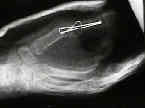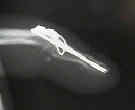- Thumb MP Joint: Tension Band Technique:
- needs to be fused in 10-20 deg flexion, 20 deg pronation, and 20 deg of abduction;
- tension band can neutralize the distraction force of the finger flexors (which are stronger than extensors and therefore cause distraction);
- dorsal incision is made over the joint;
- extensor tendon is split longitudinally and halves are retracted;
- joint surfaces are molded into opposition;
- because of the cam shape of the phalangeal (or metacarpal heads) more molding is required on the volar surface (where visualization is difficult);
- transverse drill hole is made thru dorsal surface of distal bone segment;
- stainless steel wire is then inserted thru the hole;
- it is easier to perform this now, rather than after transected bone surfaces have been reduced and fixed;
- two parallel K wires are placed across the joint to provide rotational stability;
- wires are first inserted retro-grade thru the proximal bone segment's dorsal bone surface at the mid point;
- joint is reduced in desired position of flexion;
- wires are then driven down meduallary canal of distal fragment;
- angle is fusion is controlled by flexing the digit (to appropriate level) and driven wires parallel to dorsal phalangeal surface;
- tension band wire is then figure of 8 wrapped over dorsal surface of bone, and wrapped around protruding K wires of proximal fragment;
- K wires are bent, cut, and rotated;
- tension wire is tensioned w/ needle driver;
- wire is cut, and bent;
- after one week, the other digits can resume normal ROM;
- fusion usually occurs at 4-6 weeks;
- PIP Joint Fusion:
- place the PIP joint in maximal flexion, and remove the distal end of the proximal phalanx w/ a volar slope;
- articular cartilage is removed from the base of the middle phalanx;
- as the finger is brought from a hyperflexed to a slightly flexed position, the transected bone ends are brought under tension;
- position of fusion:
- 20-25 deg of flexion in the index finger;
- 30 deg of flexion in the long finger;
- 40 deg of flexion in the ring finger;
- 40-50 deg of flexion in the little finger;
- fixation:
- longitudinal K wire is placed across the joint;
- oblique K wire is placed across the joint;
- DIP Joint Fusion:
- usually DIP joints of the lesser fingers are fused in a straight position (or slight flexion);
- use an H shaped incision w/ the vertical limbs placed as mid lateral incisions;
- this exposure allows access to the distal portion of the collateral ligaments;
- the distal flap should be full thickness down to extensor tendon inorder to ensure viability;
- DIP joint is distracted, joint surface is removed, and the bone ends are made congruous (either flat or cup in cone);
- use 0.035 inch K wire to drill hole for 26 guage (or No. 0) stainless steel wire;
- hole is inserted 5 mm from bone ends, dorsal to the mid-axis;
- wire loop is made but is not tightened down until after a longitudinal K wire is inserted retrograde across the joint;
- wire is tightened down, and end is placed into intra-osseous hole;
- controversies: intentional fibrous union:
- based on the observation that many "failed" DIP joint fusions (fibrous union) remain pain free and yet maintain some motion;
- procedure is best indicated in the little and ring fingers, but is less indicated in the thumb, index, and long fingers (where a stable pinch is more important);
- technique involves excision of the joint and insertion of 2 K wires for 2 weeks;
- after 2 weeks, the wires are removed and the joint is splinted for an additional 2 weeks;
- complications:
- quadriga
- result of quadriga is decreased grip strength;
- may be most pronounced in the index and long fingers;
- may be prevented by fusion w/ DIP flexion;
- Thumb IP Joint Fusion:
- often indicated in RA or CMT disease;
- should be fused in 10-20 deg of flexion
Tension Band Arthrodesis in the Hand.
Tension Band Arthrodesis in the Finger Joints.
Osteoarthritis of the proximal interphalangeal joint of the hand: arthroplasty or fusion?
Tension band arthrodesis of small joints in the hand.
Intraosseous Wiring of the Digital Skeleton.
Effectiveness of the chevron arthrodesis in small joints of the hand.
The impact of simulated distal interphalangeal joint fusion on grip strength.
Thumb metacarpophalangeal joint arthrodesis using the AO 3.0-mm cannulated screw: surgical technique.
Arthrodesis of the thumb metacarpophalangeal joint using a cannulated screw and threaded washer.









